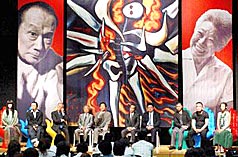A Japanese Mural in Mexico

An important antiwar mural painted in Mexico by famed Japanese modern artist, Taro Okamoto (1911 - 1996), has been rediscovered after thirty five years. In Spanish the work is known as Mito del Mañana (Myth of Tomorrow), and in Japanese, Ashita no Shinwa - but like all great works of art, Okamoto’s painting speaks a universal language. The gigantic mural depicts the exact moment of an atomic bomb explosion, with the focus of the work being an anonymous human reduced to skeletal form and burning under an atomic sun.
Okamoto’s mural was originally painted in the lobby of what was to be a high-rise luxury hotel in Mexico City, but the developer encountered financial troubles that prevented the building’s completion. Okamoto’s wall painting, dismantled and put into storage, eventually disappeared - and it remained missing until just recently. In 2003 the mural was found abandoned in a yard for building materials located in a suburb of Mexico City. The Taro Okamoto Memorial Museum in Japan sent a team of restorers to Mexico to evaluate the condition of the artwork, and found that it was suffering minor damage. Calling the piece "Taro’s magnum opus", the institution obtained the rights to the mural earlier this year. The mural has been shipped to Japan where museum staff and experts began restoration work in July, 2005. Okamoto’s mural will eventually be placed on public display at the end of 2006.

The Taro Okamoto Memorial Foundation for the Promotion of Contemporary Art released a statement that in part read, "Okamoto believed that the myths of the future develop at moments of cruelty and tragedy. This mural speaks from his deepest thoughts, from his heart." While the world’s first atomic bombing of civilian population centers occurred in August 1945 when the U.S. devastated Hiroshima and Nagasaki with nuclear fire… it would be a mistake to see Okamoto’s artwork as fixated on those terrible events. Rather, his striking mural is a warning to all humanity, and the message is more relevant today than ever before. That we’ve grown accustomed to living with a nuclear Sword of Damocles hanging above us all is really the core meaning of the mural’s title - and our continued apathy only assures that tomorrow is indeed a myth.
Painted between 1968 and 1969 and measuring some 18 feet high by 98 feet long, Okamoto’s artwork is a powerful indictment of war. While it may seem incongruous that such a disturbing and forceful work of art would appear in the lobby of a luxury hotel, one must remember that Mexican restaurants, hotels, commercial and government buildings have often made wall space available for the display of controversial large-scale public artworks. The Mexican Muralist Movement led by greats David Alfaro Siqueiros, Diego Rivera and José Clemente Orozco, set the standards for a progressive and internationalist school of art. The radical and populist artworks of these masters and the many others who worked shoulder to shoulder with them, enhance public space all across Mexico. There’s absolutely no doubt that Taro Okamoto was inspired and influenced by the remarkable Mexican school of socially conscious artists, and the discovery and restoration of his mural is cause for celebration.


<< Home